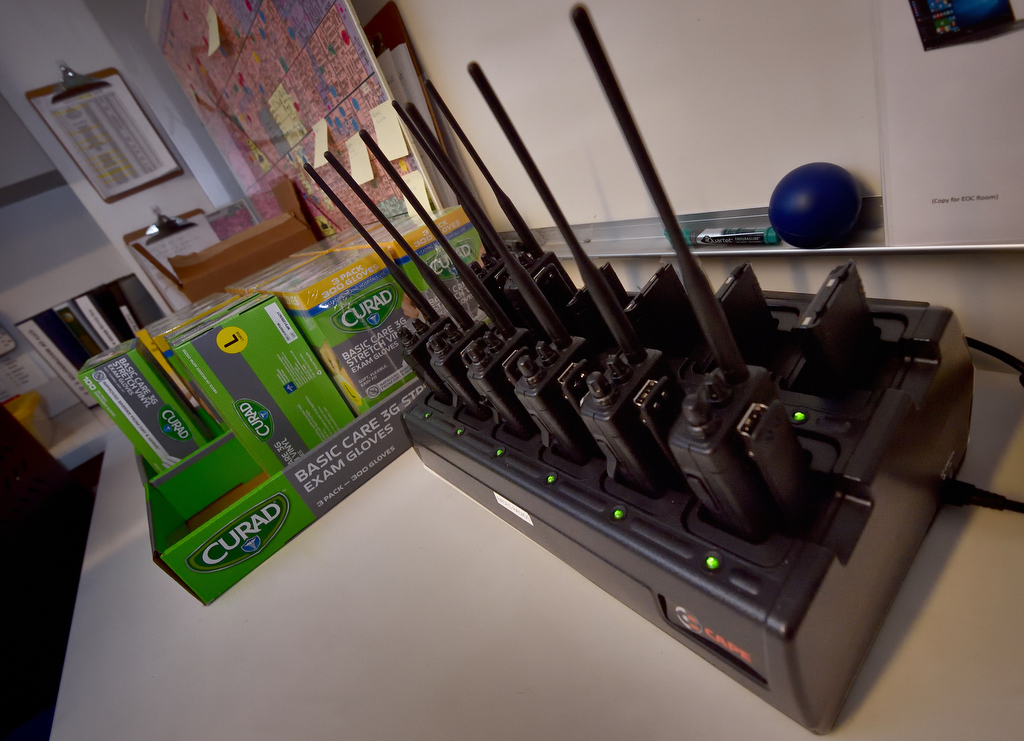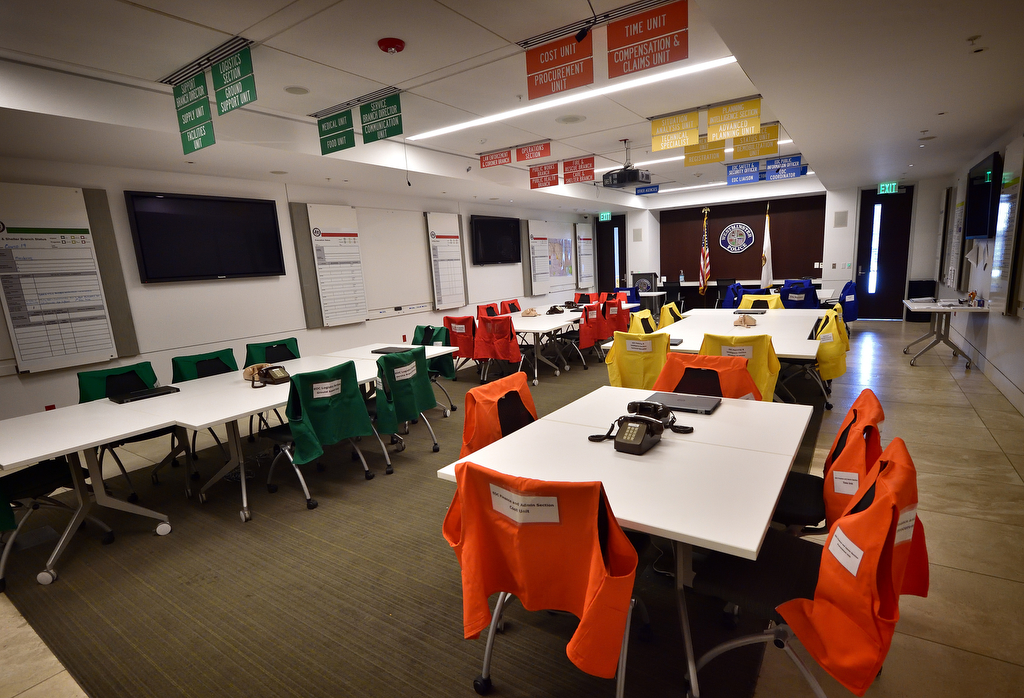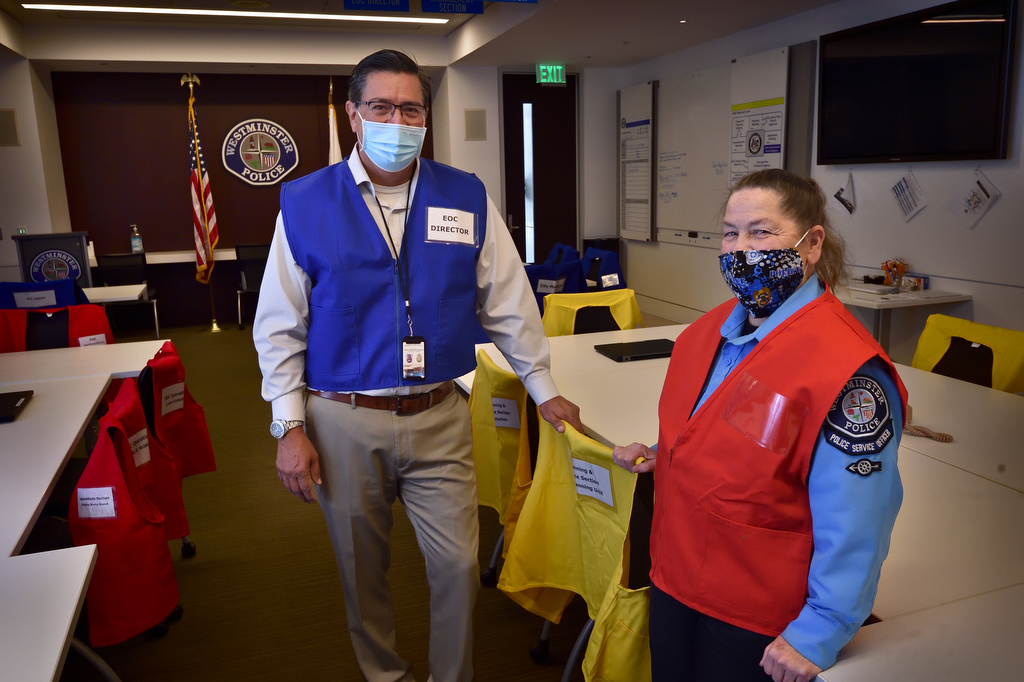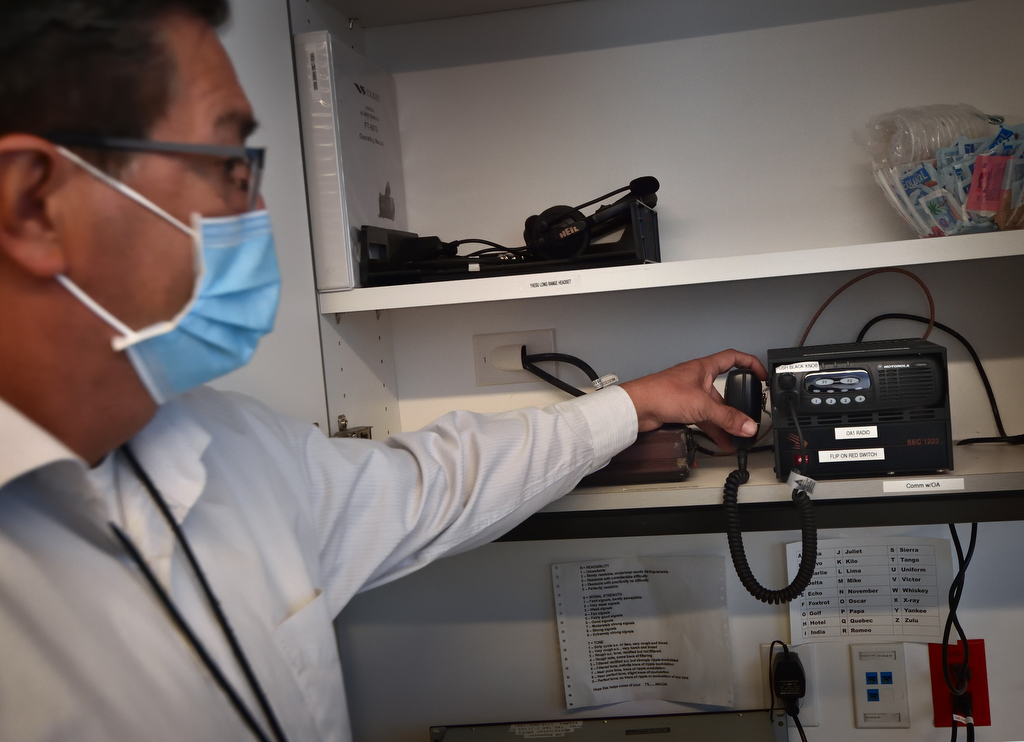Westminster’s Emergency Operations Center has been busy.
First came the COVID-19 stay-at-home orders for California in March.
Then, it was the Black Lives Matter demonstrations in June and more recently, the November elections.
“It’s a tool that we use to manage all risk emergencies,” said Robert Acosta, Westminster Police Department’s Emergency Services Coordinator, overseeing the Emergency Operations Center (EOC). “Usually it’s an event that’s going to extend multi-operational periods.”

Short wave radios for use by the Emergency Operations Center team for operators out in the field during an event.
Photo by Steven Georges/Behind the Badge
EOCs are an organizational tool used by cities and agencies to coordinate efforts among multiple departments, including finance, logistics, operations and planning for large-scale emergency events. For widespread emergencies like wildfires, flooding, and earthquakes, the Orange County EOC is activated.
“They’re kind of the central ordering point and we coordinate with them,” Acosta said.
Retired from the Orange County Fire Authority, Acosta has worked with many EOCs. The idea behind them, he said, is to centralize city and emergency personnel to more efficiently mitigate the emergency, distribute resources, and remediate the affected area.
“Westminster has a well-functioning EOC,” he said.
Westminster’s EOC is located in the police station, though it can be adapted to a mobile format — as it was during the Black Lives Matter demonstrations — if necessary.

Inside the City of Westminster’s EOC (Emergency Operations Center) with color coded stations of operations located at the Westminster Police station.
Photo by Steven Georges/Behind the Badge
“It allows us to have the entities of the finance, logistics, operations and planning … all in the same room, being able to communicate in real time,” Acosta said.
The EOC can operate at various activation levels. For example, the lowest level was used for the election.
“It was just the unstaffed activation,” he said. “So, it’s activated in the sense that we’ve notified the county (EOC) that’s it’s up, it’s assembled, but it’s unstaffed.”
For COVID-19, the EOC activated to level two — after the county, state, and federal governments all declared emergencies for their regions.
“So once there’s a declaration of emergency, it’s important to open our EOC at that time,” he said.

Emergency Services Coordinator for the City of Westminster Robert Acosta with Police Service Officer and EOC officer Cyn-d Moranville inside the City of Westminster’s EOC (Emergency Operations Center) at the Westminster police station.
Photo by Steven Georges/Behind the Badge
The EOC was set up with the necessary tools, equipment, and tech like computers, radios, and TVs, but most of the team worked remotely. Coordination was required for things like determining COVID-19 hotspots as well as developing a sanitization procedure for officers to follow.
“It was such a slow-moving event that it was never fully staffed,” Acosta said.
One benefit of centralizing key police and city department personnel in one space is having the right people in place to quickly accomplish tasks and have access to the appropriate resources. There are four chiefs (for operations, planning, logistics and finance) with teams of three to four. The relevant city or police department directors head the teams. This helps with efficient coordination efforts.
For example, if an emergency requires 50 sheets of drywall, that could be easily accessed by the EOC’s logistics chief, who is the director of public works and familiar with the city’s established contract with The Home Depot.
“That’s why those directors are ideal in those spots,” Acosta said. The EOC also builds in backups in case someone is not available during an EOC activation.
When the city became aware that Black Lives Matter demonstrations would be taking place in Westminster, the EOC was activated to the highest level, Acosta said, because they anticipated two protests and several hundred people marching to City Hall, which is adjacent to the police station. The event required additional police officers over a large part of the city.
“(The event had) very high potential to be something that we would need to manage and mitigate,” he said.

Emergency Services Coordinator Robert Acosta shows an operational area radio available for use by the Westminster EOC team to communicate with the Loma Ridge EOC as well as other EOC teams throughout the county. Telephone, internet, and radio repeater systems cannot be depended on to be in operation during an emergency.
Photo by Steven Georges/Behind the Badge
The EOC was moved offsite to a mobile unit because the protests were expected to take place in front of the police station.
“It was very peaceful. Nobody was hurt, nobody was violent,” Acosta said. “We were able to break down the EOC by the next day.”
With the pandemic being an ongoing concern, Westminster Sgt. Ron Weber said the EOC could be activated again. With all the real-life practice from the activations this year, he said, the EOC is much better prepared for future activations for COVID-19 or any other major incidents in the city.
“I think it would fire up instantly and everyone for the most part would be able to jump on their roles and handle their assignments in their roles,” Weber said.
Westminster Interim City Manager Sherry Johnson said having Acosta as the newly hired coordinator has made a difference in the EOC’s running.
“He has been a big part of keeping our first responders equipped with needed PPE (personal protective equipment),” she said. “He has also helped us apply to FEMA (the Federal Emergency Management Agency) to retrieve some of the city costs. Another nice result of having an assigned member is that he is able to communicate with surrounding cities to see that we are all following the same protocols.”
 Behind the Badge
Behind the Badge



